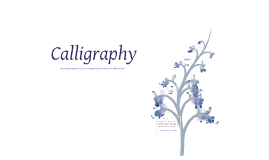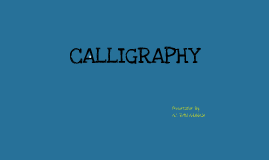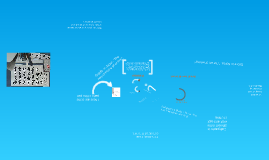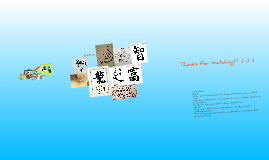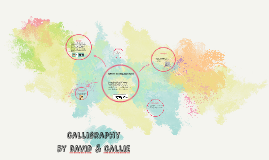Calligraphy
Transcript: This is our Humanities project! Our Chinese invention is calligraphy! By: Jasper Peralta & Rama Fattel Presentation by: Jasper Peralta The word calligraphy comes from two Greek words. Those two Greek words are kallos and graphos! These words mean beautiful, writng, and drawing! Tools for Writing Calligraphy They use calligraphy in Greece! They use it in Japan! Of course China! It's in the West, too! Finally, it's in ROME! There are five main types of calligraphy! Xing shu Xing shu is used for artistic writing! It was created in 300 b.c.e.! This calligraphy is an art form! Zhuan shu Zhuan shu is used everywhere in China! It was created in 221b.c.e.! This type of calligraphy is used for personal signature! Li shu Li shu is used for record keeping! It was created during the Han Dynasty! This calligraphy was created in 220 b.c.e.! Cao shu Cao shu is used for note writing! It was created in 650 b.c.e.! All though it is a type of calligraphy it is the least beautiful! Kai shu Kai shu is used for printing books! Kai shu is just ordinary handwriting! It was invented in 250 b.c.e.! The purpose and advancements of Chinese calligraphy! The Chinese had to use silk, then the invention of paper was tremendous because it asorbed ink better! The social and political use of calligraphy has radically changed! Calligraphy is no longer an art associated primarily with traditionaly scholarly elite! Artists found ways to challenge traditions rather than perpetrate them! Calligraphy Extras: Works Cited: Books: Shuter, Jane. Ancient Chinese Art. Chicago, Illinois: Heiman Library, 2001. Print. Frey, Wendy. History Alive. U.S.A.: Teacher Curriculum Institute, 2004. Print. Encyclopedia: "Calligraphy." Compton's C-Child. 4th ed. 2008. Print. Internet: "Calligraphy in Modern China." Washington.edu. Web. May 6, 2010. <www.washington.edu> "What is Calligraphy." Chinavoc. Chinavoc, 2001-2007. Web. May 6, 2010. <www.chinavoc.com> Thanks For Watching!!! :) :) :) The word calligraphy comes from two greek words. In China and Japan, they traditionally use brush, paper, ink, and silk. Western people use just a pen, brush, and paper. Symbol for wisdom The Chinese use mallets and metal chisels for wood, stone, and hard metal. 5. It is important to load pen with just enough ink! Each chaaracter must stay in porportion with each other! They use calligraphy in the West! 1. They used blunt pointed tools, such as, a ball point pen or a fiber-tipped pen. Where did the word come from? the words mean; beautiful, writing and/or drawing. 2. 3. Symbol for Way of Bonsai! Symbol for Chinese Dragon! 4. Symbol for Wealth You must have your character perfectly written! this may seem easy, but it is very difficult! They use it in Greece It is a neccessary to hold your brush correctly! When you write with pens they are usually made of reeds, feathers, and metal. You must have patience and be able to copy even brush strokes! THe two words are Kallos and graphos.






